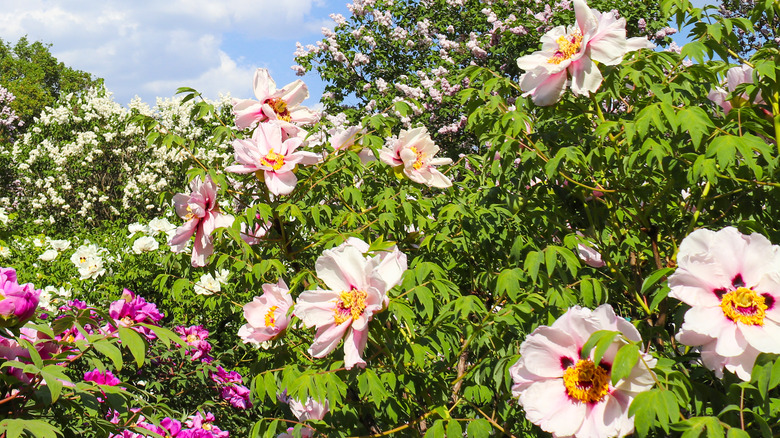The Majestic Peonies That Grow To Spectacular Heights And Boast Gorgeous Blooms
Flower enthusiasts — say hello to the new crown jewel of your garden. Woody peonies, or Paeonia suffruiticosa, are towering shrubs that produce large sweet-smelling blooms. Also known as tree peonies, these statement plants have graced gardens around China for centuries. There are several types of tree peonies and the shrubs vary in size and shape. The flowers also come in all kinds of exotic colors, from purple to coral to creamy yellow.
The difference between tree peonies and herbaceous peonies is that tree peonies have perennial woody stems. These stems grow above the ground year after year until they reach soaring heights, with wide blooms of up to nine inches for some varieties, according to the American Peony Society. Planting and caring for tree peonies is similar to caring for herbaceous peonies in many ways, although there are some key differences to keep in mind if you plan to introduce these majestic flowers to your garden.
How to successfully grow tree peonies
Soaring up to 7 feet tall, tree peonies will be the star sensation of your garden. The sturdy stems do not die to the ground in the colder months and will continue to grow, albeit slowly, every year. According to the American Peony Society, tree peonies can thrive in almost all of the USA plant hardiness zones, aside from the hottest and coldest regions.
Woody peonies should be planted directly into the ground for optimal growth. Use well-draining, nutrient-rich loose soil and plant in an area with sun exposure as well as partial shade. The placement is important as they need plenty of space around them to reach their full potential. Remember that these flowers will become fixtures of your garden for many years; create a designated space that is sheltered from the elements and away from other plants that may compete for resources.
Burying the roots too deeply is one of the most common mistakes everyone makes when growing peonies, but in fact, the opposite is true for woody peonies. It is essential to plant woody peonies deep into the ground to support a healthy root system. The depth will vary based on the climate in your region, but generally, the hole should cover at least four inches of the stem. Water generously as you plant and add a layer of composted mulch to preserve the moisture.
Important things to consider about tree peonies
The first two years are the most precarious for woody peonies and will require the most supervision and care. Don't get discouraged if you don't see much activity during this time, as the plants are busy forming strong roots. As we mentioned, woody peonies are slow-growing and we gardeners are playing the long game.
Many flower enthusiasts know that it's unwise to plant peonies in the spring, and the same goes for woody peonies. It is best to wait until autumn when their flowering season has passed to give them enough time to settle in for the following year. Keep in mind that these shrubs are quite intolerant of excess moisture. Do not water the soil unless it's necessary, and ensure that their growing area does not become too wet.
Tree peonies are susceptible to similar diseases as their herbaceous counterparts, such as botrytis blight. This fungus will appear as gray or black discoloration on the plants and typically develops in overly moist environments. The best way to prevent it is by monitoring the plant, removing affected flowers, and treating the plant with fungicide.


